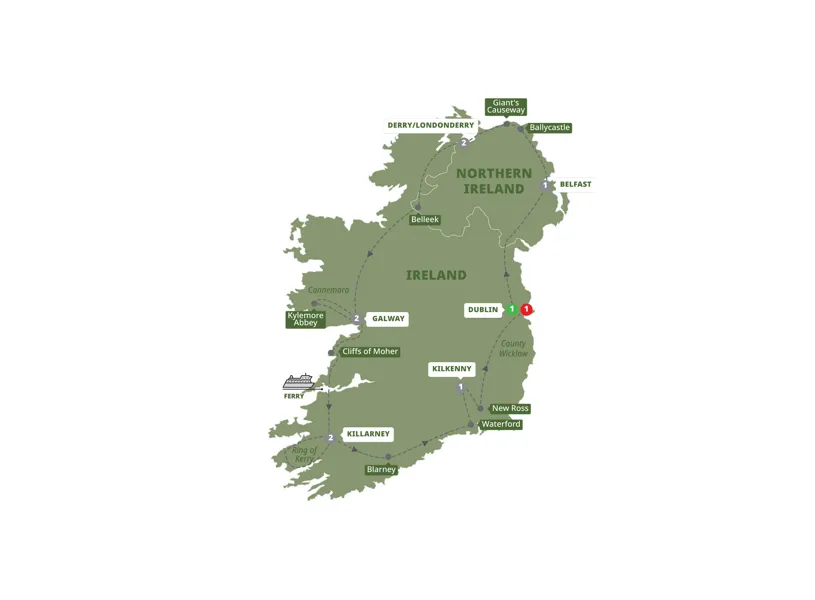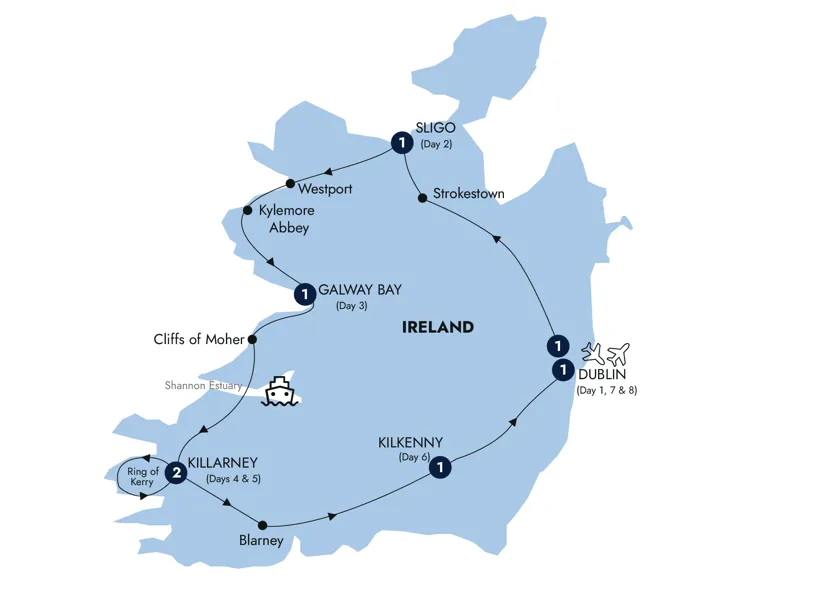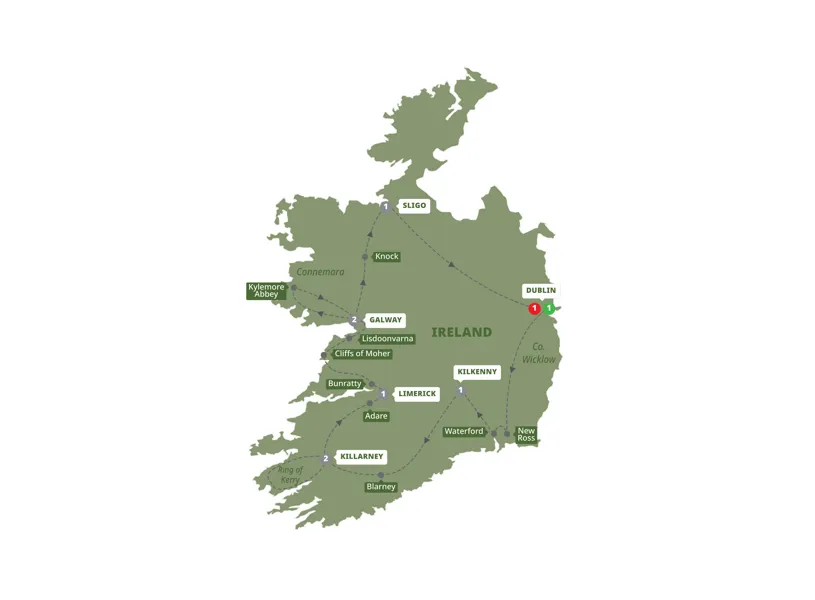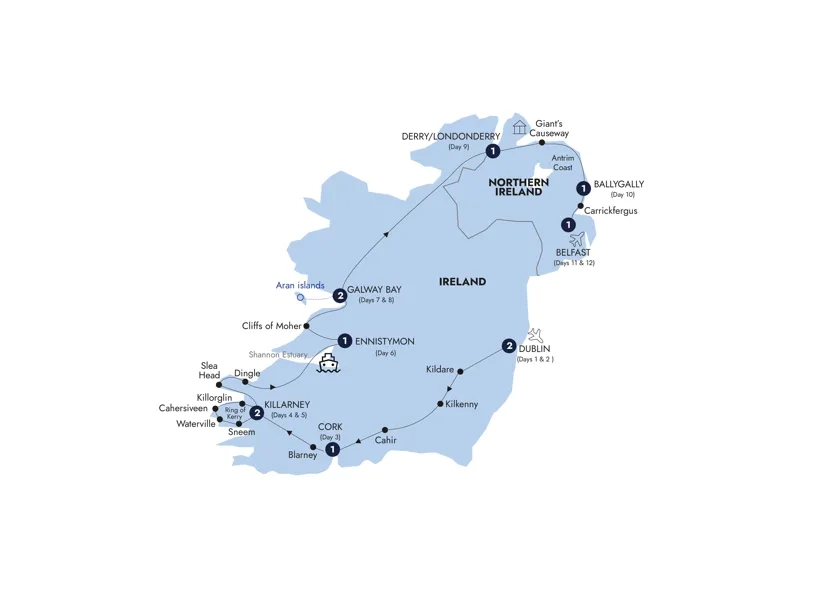Who can resist the charm of the Emerald Isle? The multi-hued green landscapes, the dramatic seaside cliffs, the hospitable locals, the lively music, and the rich history. Experience it all on a tour of Ireland.

Call Us
Mon - Fri: 6:30am - 5:30pm PST
Closed Sat & Sun
Christmas Day: Closed Thursday December 25

Call Us
Mon - Fri: 6:30am - 5:30pm PST
Closed Sat & Sun
Christmas Day: Closed Thursday December 25
About Us
For more than 50 years, Grand European Travel has been providing a wonderfully simple, and genuinely personal, way to travel.
Meet Our Team
Our Travel Specialists make planning your trip fun and hassle free
Guided Vacations
Top 10 advantages of taking a guided tour
Guest Reviews
As you plan your trip, read our unedited guest reviews
Travel Insurance
Protect your vacation with travel insurance.
Responsible Travel
Powered by our not-for-profit foundation, TreadRight
Current Offers
From Last Minute Deals to limited time promotions, see all offers.
Big Travel Sale
SAVE up to 15% on 2026 Tours
Double Past Traveler
Double Global Tour Rewards on select trips
GETAWAY Deals
Great deals on last minute travel
AARP Member Benefits
Enjoy exclusive savings on guided tours and river cruises
2027 Cruise Savings
Early Booking Savings up to 20%
Solo Traveler Deals
2026 Single Supplement Cruise Discounts
The History of Guinness Stout
& How to Pour the Perfect Pint

Is anything more closely identified with Ireland than a pint of Guinness Stout? Like the British Empire itself, Guinness has colonized taste buds around the world. By the end of the twentieth century, the beer was sold in over 150 countries and brewed in 49. The Guinness Brewery and Storehouse are the most visited attraction in Dublin. With a rich roasted aroma and a hue of midnight ruby, Guinness, an Irish dry stout, has been an emblem of Ireland for over two centuries, and a pint is a must-taste for visitors to Ireland.
History of The St. James’s Gate Brewery, Dublin
Guinness Stout has been crafted at the St. James’s Gate Brewery since 1759 when Arthur Guinness launched his enterprise by signing a 9,000-year lease for the four-acre property. Records show he was preceded by another brewery that started operating there in 1670.
Initially, Mr. Guinness brewed ale. However, a new style of beer called porter was seizing the market, and Guinness embraced the trend. By 1779, the Guinness Brewery was listed as one of two official suppliers of beer and ale to the seat of government at Dublin Castle. Five years later it was the exclusive porter supplier. By 1799, Guinness had eliminated ales entirely in favor of darker brews.
Guinness became Ireland’s largest brewery in 1838, and the world’s largest by 1886, making 1.2 million barrels annually. It is still the largest brewer of stout in the world. After remaining a family business for five generations, changes in ownership punctuated the last half-century, and today it’s owned by Diageo, a British multinational beverage company.
The Guinness Storehouse, St. James's Gate, Dublin
The Guinness Storehouse is a converted brewing facility housing a museum of all things Guinness. The Storehouse covers seven floors surrounding a glass atrium shaped in the form of a pint of Guinness. The ground floor introduces the beer's four ingredients (water, barley, hops, and yeast), and the brewery's founder, Arthur Guinness. An exhibit of company history, brewing techniques, ingredients, and Guinness’s celebrated advertising campaigns culminates at the glass-wrapped Gravity Bar on the seventh floor.

What to Do at the Guinness Storehouse
The Gravity Bar invites visitors to savor a pint of Guinness while taking in a nearly 360-degree panorama of Dublin and the working 64-acre brewery below. Other Storehouse attractions include the Perfect Pint bar, where visitors may pour their own pint with expert coaching — a carefully prescribed process that takes nearly two minutes. Also on site are several restaurants and a copy of the 9000-year lease, now void: Guinness bought the property many years ago.
Amazing Ireland
Day 1
Welcome to the Emerald IsleDay 2
Onwards to Beautiful BelfastDay 3
BelfastDay 4
Venture to the Giant’s Causeway and on to Derry/Londonderry and County DonegalDay 5
Admire Belleek’s Famous PotteryDay 6
Pilgrimage to Knock and on to GalwayDay 7
Admire Stunning ConnemaraDay 8
Explore the Cliffs of Moher and KillarneyDay 9
A Day on the Ring of KerryDay 10
See the Sights in Blarney, Cork and WaterfordDay 11
Uncover the Treasures of KilkennyDay 12
Venture to Wexford and Return to DublinDay 13
Discover Diverse DublinDay 14
Farewell Ireland
Irish Experience
Day 1
Welcome to IrelandDay 2
Journey to Colorful BelfastDay 3
Venture to the Giant’s Causeway and on to Derry/LondonderryDay 4
Discover Derry/Londonderry’s PastDay 5
Onwards to Scenic GalwayDay 6
Connemara ExcursionDay 7
Explore the Cliffs of Moher and KillarneyDay 8
A Day on the Ring of KerryDay 9
Off to Blarney, Waterford and KilkennyDay 10
Through County Wicklow’s Countryside to DublinDay 11
Farewell Dublin
Irish Highlights
Day 1
Welcome to the Emerald IsleDay 2
Onwards to LimerickDay 3
Experience the Iconic Cliffs of Moher and on to KillarneyDay 4
A Scenic Day on the Ring of KerryDay 5
Explore Blarney and Journey to WaterfordDay 6
Through County Wicklow’s Countryside to DublinDay 7
Farewell Ireland
Enchanting Ireland
Day 1
Hello DublinDay 2
Experience Irish history and on to SligoDay 3
Journey to Westport and GalwayDay 4
The Iconic Cliffs of Moher and Onwards to KillarneyDay 5
A Day on the Ring of KerryDay 6
Venture to Blarney and Medieval KilkennyDay 7
Return to Lively DublinDay 8
Farewell Ireland
Best of Ireland
Day 1
Welcome to IrelandDay 2
Through the Scenic County Wicklow and Waterford to KilkennyDay 3
Journey to Blarney and on to KillarneyDay 4
A Day on the Ring of KerryDay 5
Onwards to Lively LimerickDay 6
Admire the Cliffs of Moher and Onwards to GalwayDay 7
A Day Exploring Stunning ConnemaraDay 8
A Pilgrimage to Knock and on to SligoDay 9
Return to Lively DublinDay 10
Farewell Ireland
Wonders of Britain and Ireland
Day 1
Welcome to LondonDay 2
Discover the Sights of LondonDay 3
Stonehenge and Bath and on to CardiffDay 4
Onwards to WaterfordDay 5
Admire Blarney Castle and Journey to KillarneyDay 6
A Day on the Ring of KerryDay 7
Journey to Cultural DublinDay 8
Dublin Your WayDay 9
The Sights of Chester and LiverpoolDay 10
Through the Lake District to EdinburghDay 11
Discover Remarkable EdinburghDay 12
Venture to YorkDay 13
On to Shakespeare’s Stratford-upon-AvonDay 14
Journey through the Cotswolds to Oxford and LondonDay 15
Goodbye London
Treasures of Ireland
Day 1
Welcome to IrelandDay 2
Journey to Waterford and CorkDay 3
See the Sights of Blarney and Killarney National ParkDay 4
A Day on the Dingle PeninsulaDay 5
Admire the Cliffs of Moher and on to LimerickDay 6
Onwards to Shannon
Country Roads of Ireland
Day 1
Welcome to DublinDay 2
In Dublin’s Fair CityDay 3
A Journey from Dublin to CorkDay 4
Across the Mountains to KillarneyDay 5
Ring of Kerry ExperienceDay 6
Around the Dingle PeninsulaDay 7
The Cliffs of Moher and GalwayDay 8
Free day Galway or Aran IslandsDay 9
Explore Derry/LondonderryDay 10
Walk in the Giant’s StepsDay 11
The Antrim Coast to BelfastDay 12
Depart Belfast
How to Pour the Perfect Pint of Guinness
Pouring a proper pint of Guinness is an art! Follow these steps to achieve that smooth, creamy perfection:
- Use a clean, dry Guinness-branded glass – The tulip shape helps the head form properly.
- Hold the glass at a 45° angle and pull the tap handle fully forward. Fill until it's about ¾ full.
- Let it settle – This is key! Wait about 119.5 seconds (yes, really!) for the nitrogen bubbles to form the iconic cascade.
- Top it off – Hold the glass straight and push the tap handle back to fill to the brim, creating a perfect domed head.
- Enjoy! – Wait a moment before sipping to let the flavors fully develop.
The Many Flavors of Guinness
Many iterations of Guinness have been brewed over its 260 years of production. Some of the famous varietals include Guinness Over the Moon Stout, Guinness's Brite Lager, Guinness's Brite Ale, Guinness Light, Guinness XXX Extra Strong Stout, Guinness Blonde, and Guinness 200th Anniversary Export Stout, and even Guinness Nitro Cold Brew Coffee.
The Most Popular Guinness Varieties Available in the USA
Guinness Extra Stout
Subtly fruity notes of fermentation with a dry finish. Available in bottles
Guinness Foreign Extra Stout
Introduced as West India Porter around 1800, winning loyalty in Africa, Asia, and the Caribbean. Today it accounts for 45% of Guinness’s global sales. This older style of stout has nearly twice the alcohol of draft Guinness, with a tart, refreshing flavor emphasizing the fruity notes of the roasted malt. Available in bottles
Guinness Draught
Smooth and creamy with balanced bittersweet flavor accented with roasted coffee and malt. Available in kegs
Frequently Asked Questions About Guinness
Is Guinness Really Good for You?
The brand’s famous 1920s slogan “Guinness is good for you” has little to do with an actual health claim. All the same, beer contains B vitamins, soluble fiber, and prebiotics which are good for your health. Guinness, though, also contains antioxidants like those found in red wine and dark chocolate, which are not found in other beers. A study by the University of Wisconsin found that, similar to wine, drinking Guinness can help to reduce blood clots and the risk of a heart attack. So, yes, in fact, it is good for you.
What’s in a pint of Guinness?
Guinness stout is made from only four key, historic ingredients — water, cereal grains, spices, and yeast. While not an ingredient, it's important to know that Guinness added nitrogen to their beers in the late 1950s, providing them with their iconic creaminess.
Why Is Guinness Dispensed by Nitro?
Today’s Guinness draught (draft, in American) is a relatively recent evolution. In 1959, Guinness developed a unique nitrogen dispensing system that results in finer, smaller bubbles than a conventional draft system, ensuring a creamier, smoother drink with a distinctive blond head. Craft brewers in the US and beyond have adopted nitro taps for many beers, to achieve a subtler texture and evenly distributed flavors, in contrast to a prickly, aroma-forward carbon-dioxide-drawn beer.
In the 1980s, Guinness launched a draft version in a can, containing a specially engineered widget that imparts finely textured nitrogen-based bubbles upon opening.
What’s the difference between porter and stout?
This question always seems to inspire a spirited debate.
Stout is a direct descendant of porter. In the 1700s, “stout” referred to any variation which was bolder, bigger, and higher alcohol, much as “lite” means the opposite today.
From an 1810 book on commerce: "Porter may be divided into two classes, namely brown-stout and porter properly so-called … Brown-stout is only a fuller-bodied kind of porter than that which serves for ordinary drinking. A great deal of this is exported to America and the West Indies."
The Beer Judge Certification Program describes stout as “a very dark, roasty, bitter, creamy ale,” and porter as “a substantial, malty dark ale with a complex and flavorful roasty character.” While some suggest stouts are defined by roasted barley or patent malt (roasted malted barley), history indicates that stout precedes both those ingredients.
You Might Also Like
Find Your Perfect Destination
 Tap To Call
Tap To Call
 Free Brochure
Free Brochure
Order Your Free Brochure
Sign up to order your FREE travel brochure subscription and get exclusive offers only available to our subscribers
Thanks for signing up to receive our latest brochure. As a subscriber, you'll be the first to receive our new brochures as they are released, plus great deals in your inbox.





















